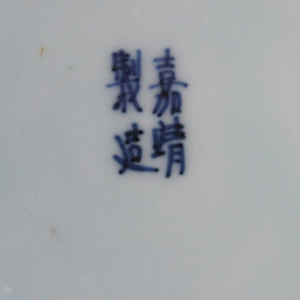
JIAJING or LONGQING c.1560 – 1570 Ming Porcelain
A Ming Blue and White Porcelain Dish, Jiajing 1522-1566 or Longqing 1567-1572 Period, c.1560-1570. Decorated with Three Phoenix Around Three Clouds and the Sun at the Center. The Base with a Four Character Mark Which Probably Reads Fu Gui Jia Qi “Fine Vessel For Wealth And Honour”.
SOLD
- Condition
- The rim has a crack c.18mm long and some firing cracks. The rim has some minor fritting.
- Size
- Diameter : 19 cm (7 1/2 inches)
- Provenance
- From a Private English Collection of Chinese and Japanese Blue and White Porcelain.
- Stock number
- 24120
- References
- For a Ming blue and white dish of this design with a Fu Gui Jia Qi "Fine Vessel For Wealth And Honour" mark to the base dated to 1550-1575 see : Chinese Ceramics in the Topkapi Saray Museum Istanbul, A Complete Catalogue II, Yuan and Ming Porcelains (Regina Krahl, Sotheby`s 1986) page 707 item 1212. Another Ming porcelain dish of this design incorrectly dated to late 17th century is illustrated in : Chinese Blue and White Ceramics (S.T. Yeo & Jean Martin, South East Asian Ceramic Society, 1978) page 160, plate 120.
Information
I have dated this dish with perhaps rather more precision than seems reasonable, but there are a number of dishes of this size and quality with similarly painted mark. These dishes have a four character mark of the very short reign of Longqing. These were most likely made during Longqing`s reign but are probably none-imperial
Phoenix / Fenghuang :
Fenghuang are mythological birds of East Asia that reign over all other birds. The males are called Feng and the females Huang. In modern times, however, such a distinction of gender is often no longer made and the Feng and Huang are blurred into a single feminine entity so that the bird can be paired with the Chinese dragon, which has male connotations. The Fenghuang is also called the `August Cockerel` since it sometimes takes the place of the cockerel in the Chinese Zodiac. In the West, it is commonly referred to as the Chinese phoenix. The Fenghuang has very positive connotations. It is a symbol of high virtue and grace. The Fenghuang also symbolizes the union of yin and yang. In ancient China, they can often be found in the decorations for weddings or royalty, along with dragons. This is because the Chinese considered the dragon and phoenix symbolic of blissful relations between husband and wife, another common yin and yang metaphor. In some traditions it appears in good times but hides during times of trouble, while in other traditions it appeared only to mark the beginning of a new era. In China and Japan it was a symbol of the imperial house, and it represented `fire, the sun, justice, obedience, and fidelity`.



